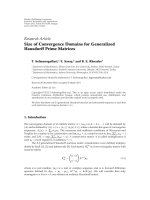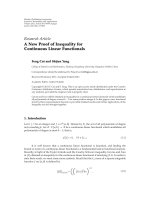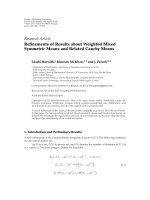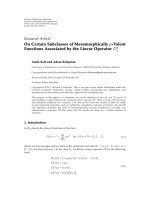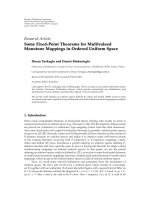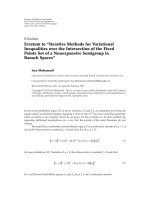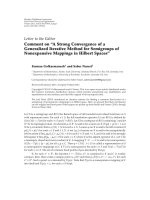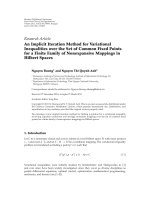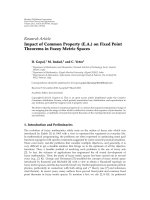Hindawi Publishing Corporation Fixed Point Theory and Applications Volume 2010, Article ID 126192, 8 ppt
Bạn đang xem bản rút gọn của tài liệu. Xem và tải ngay bản đầy đủ của tài liệu tại đây (478.11 KB, 8 trang )
Hindawi Publishing Corporation
Fixed Point Theory and Applications
Volume 2010, Article ID 126192, 8 pages
doi:10.1155/2010/126192
Research Article
Existence of Solution and Positive Solution for
a Nonlinear Third-Order m-Point BVP
Jian-Ping Sun and Fan-Xia Jin
Department of Applied Mathematics, Lanzhou University of Technology, Lanzhou,
Gansu 730050, China
Correspondence should be addressed to Jian-Ping Sun,
Received 5 November 2010; Accepted 14 December 2010
Academic Editor: Tomonari Suzuki
Copyright q 2010 J P. Sun and F X. Jin. This is an open access article distributed under the
Creative Commons Attribution License, which permits unrestricted use, distribution, and
reproduction in any medium, provided the original work is properly cited.
In this paper, we are concerned with the following nonlinear third-ord er m-point boundary value
problem: u
tft, ut,u
t 0, t ∈ 0, 1, u0A, u
1 −
m−2
i1
a
i
u
ξ
i
B, u
0C.Some
existence criteria of solution and positive solution are established by using the Schauder fixed
point theorem. An example is also included to illustrate the importance of the results obtained.
1. Introduction
Third-order differential equations arise in a variety of different areas of applied mathematics
and physics, for example, in the deflection of a curved beam having a constant or varying
cross-section, a three-layer beam, electromagnetic waves, or gravity-driven flows and so on
1.
Recently, third-order two-point or three-point boundary value problems BVPs have
received much attention from many authors; see 2–10 and the references therein. In
particular, Yao 10 employed the Leray-Schauder fixed point theorem to prove the existence
of solution and positive solution for the BVP
u
t
f
t, u
t
,u
t
0,t∈
0, 1
,
u
0
A, u
1
B, u
0
C.
1.1
Although there are many excellent results on third-order two-point or three-point
BVPs, few works have been done for more general third-order m-point BVPs 11–13.Itis
2 Fixed Point Theory and Applications
worth mentioning that Jin and Lu 12 studied some third-order differential equation with
the following m-point boundary conditions:
u
0
0,u
1
m−2
i1
a
i
u
ξ
i
,u
0
0. 1.2
The main tool used was Mawhin’s continuation theorem.
Motivated greatly by 10, 12, in this paper, we investigate the f ollowing nonlinear
third-order m-point BVP:
u
t
f
t, u
t
,u
t
0,t∈
0, 1
,
u
0
A, u
1
−
m−2
i1
a
i
u
ξ
i
B, u
0
C.
1.3
Throughout, we always assume that a
i
≥ 0 i 1, 2, ,m− 2 and 0 <ξ
1
<ξ
2
< ··· <ξ
m−2
< 1.
The purpose of this paper is to consider the local properties of f on some bounded sets and
establish some existence criteria of solution and positive solution for the BVP 1.3 by using
the Schauder fixed point theorem. An example is also included to illustrate the importance of
the results obtained.
2. Main Results
Lemma 2.1. Let
m−2
i1
a
i
/
1. Then, for any v ∈ C0, 1,theBVP
u
t
v
t
,t∈
0, 1
,
u
0
A, u
1
−
m−2
i1
a
i
u
ξ
i
B
2.1
has a unique solution
u
t
B −
m−2
i1
a
i
1
ξ
i
v
s
ds
1 −
m−2
i1
a
i
t A −
1
0
G
t, s
v
s
ds, t ∈
0, 1
,
2.2
where
G
t, s
⎧
⎨
⎩
s, 0 ≤ s ≤ t ≤ 1,
t, 0 ≤ t ≤ s ≤ 1.
2.3
Proof. If u is a solution of the BVP 2.1, then we may suppose that
u
t
Mt N −
1
0
G
t, s
v
s
ds, t ∈
0, 1
.
2.4
Fixed Point Theory and Applications 3
By the boundary conditions in 2.1, we know that
M
B −
m−2
i1
a
i
1
ξ
i
v
s
ds
1 −
m−2
i1
a
i
,N A.
2.5
Therefore, the unique solution of the BVP 2.1
u
t
B −
m−2
i1
a
i
1
ξ
i
v
s
ds
1 −
m−2
i1
a
i
t A −
1
0
G
t, s
v
s
ds, t ∈
0, 1
.
2.6
In the remainder of this paper, we always assume that
m−2
i1
a
i
/
1. For convenience,
we denote
R
−∞, ∞
,R
0, ∞
,R
−
−∞, 0
,
σ
2
1 −
m−2
i1
a
i
2
m−2
i1
a
i
1 −
m−2
i1
a
i
,η max
|
A
|
,
B
1 −
m−2
i1
a
i
,
|
C
|
σ
.
2.7
The following theorem guarantees the existence of solution for the BVP 1.3.
Theorem 2 .2. Assume t hat f : 0, 1 × R × R → R is continuous and there exist c>0 and
1/4 ≤ k ≤ 1/2 such that
max
f
t, u, v
: t ∈
0, 1
,
|
u
|
≤ 4η c,
|
v
|
≤ σk
4η c
≤ σ
4k − 1
η kc
. 2.8
Then the BVP 1.3 has one solution u
0
satisfying
|
u
0
t
|
≤ 4η c, t ∈
0, 1
,
u
0
t
≤ σk
4η c
,t∈
0, 1
.
2.9
Proof. Let E C0, 1 × C0, 1 be equipped with the norm u, v max{u
∞
, v
∞
/σk},
where u
∞
max
t∈0,1
|ut|.ThenE is a Banach space.
Let vtu
t, t ∈ 0 , 1. Then the BVP 1.3 is equivalent to the following system:
u
t
v
t
,t∈
0, 1
,
v
t
−f
t, u
t
,v
t
,t∈
0, 1
,
u
0
A, u
1
−
m−2
i1
a
i
u
ξ
i
B, v
0
C.
2.10
4 Fixed Point Theory and Applications
Furthermore, it is easy to know that the system 2.10 is equivalent to the following system:
u
t
B −
m−2
i1
a
i
1
ξ
i
v
s
ds
1 −
m−2
i1
a
i
t A −
1
0
G
t, s
v
s
ds, t ∈
0, 1
,
v
t
C −
t
0
f
s, u
s
,v
s
ds, t ∈
0, 1
.
2.11
Now, if we define an operator F : E → E by
F
u, v
F
1
u, v
,F
2
u, v
, 2.12
where
F
1
u, v
t
B −
m−2
i1
a
i
1
ξ
i
v
s
ds
1 −
m−2
i1
a
i
t A −
1
0
G
t, s
v
s
ds, t ∈
0, 1
,
F
2
u, v
t
C −
t
0
f
s, u
s
,v
s
ds, t ∈
0, 1
,
2.13
then it is easy to see that F : E → E is completely continuous and the system 2.11 and so
the BVP 1.3 is equivalent to the fixed point equation
F
u, v
u, v
,
u, v
∈ E. 2.14
Let V {u, v ∈ E : u, v≤4η c}.ThenV is a closed convex subset of E. Suppose
that u, v ∈ V .Thenu
∞
≤ 4η c and v
∞
≤ σk4η c.So,
|
u
t
|
≤ 4η c, t ∈
0, 1
, 2.15
|
v
t
|
≤ σk
4η c
,t∈
0, 1
, 2.16
which implies that
f
t, u
t
,v
t
≤ σ
4k − 1
η kc
,t∈
0, 1
. 2.17
Fixed Point Theory and Applications 5
From 2.16 and 1/4 ≤ k ≤ 1/2, we have
F
1
u, v
∞
≤ max
t∈0,1
⎛
⎝
B
1 −
m−2
i1
a
i
m−2
i1
a
i
1
ξ
i
v
s
ds
1 −
m−2
i1
a
i
⎞
⎠
t
|
A
|
max
t∈0,1
1
0
G
t, s
|
v
s
|
ds
≤
B
1 −
m−2
i1
a
i
σk
4η c
m−2
i1
a
i
1 −
m−2
i1
a
i
|
A
|
σk
4η c
2
≤ 2η
2
m−2
i1
a
i
1 −
m−2
i1
a
i
2
1 −
m−2
i1
a
i
σk
4η c
4η
k
1
2
kc.
2.18
On the other hand, it follows from 2.17 that
F
2
u, v
∞
max
t∈0,1
C −
t
0
f
s, u
s
,v
s
ds
≤
|
C
|
1
0
f
s, u
s
,v
s
ds
≤ ση σ
4k − 1
η kc
σk
4η c
.
2.19
In view of 2.18 and 2.19, we know that
F
1
u, v
,F
2
u, v
max
F
1
u, v
∞
,
F
2
u, v
∞
σk
≤ 4η c,
2.20
which shows that F : V → V . Then it follows from the Schauder fixed point theorem that
F has a fixed point u
0
,v
0
∈ V. In other words, the BVP 1.3 has one solution u
0
,which
satisfies
|
u
0
t
|
≤ 4η c, t ∈
0, 1
,
u
0
t
≤ σk
4η c
,t∈
0, 1
.
2.21
On the basis of Theorem 2.2, we now give some existence results of nonnegative
solution and positive solution for the BVP 1.3.
6 Fixed Point Theory and Applications
Theorem 2.3. Assume that A ≥ 0, B ≥ 0, C ≤ 0,
m−2
i1
a
i
< 1, f : 0, 1 × R
× R
−
→ R
is
continuous, and there exist c>0 and 1/4 ≤ k ≤ 1/2 such that
max
f
t, u, v
: t ∈
0, 1
, 0 ≤ u ≤ 4η c, −σk
4η c
≤ v ≤ 0
≤ σ
4k − 1
η kc
.
2.22
Then the BVP 1.3 has one solution u
0
satisfying
0 ≤ u
0
t
≤ 4η c, t ∈
0, 1
,
−σk
4η c
≤ u
0
t
≤ 0,t∈
0, 1
.
2.23
Proof. Let
f
1
t, u, v
⎧
⎨
⎩
f
t, u, v
,
t, u, v
∈
0, 1
× R
× R
−
,
f
t, u, 0
,
t, u, v
∈
0, 1
× R
× R
,
f
2
t, u, v
⎧
⎨
⎩
f
1
t, u, v
t, u, v
∈
0, 1
× R
× R,
f
1
t, 0,v
t, u, v
∈
0, 1
× R
−
× R.
2.24
Then f
2
: 0, 1 × R × R → R
is continuous and
max
f
2
t, u, v
: t ∈
0, 1
,
|
u
|
≤ 4η c,
|
v
|
≤ σk
4η c
max
f
t, u, v
: t ∈
0, 1
, 0 ≤ u ≤ 4η c, −σk
4η c
≤ v ≤ 0
≤ σ
4k − 1
η kc
.
2.25
Consider the BVP
u
t
f
2
t, u
t
,u
t
0,t∈
0, 1
,
u
0
A, u
1
−
m−2
i1
a
i
u
ξ
i
B, u
0
C.
2.26
By Theorem 2.2, we know that the BVP 2.26 has one solution u
0
satisfying
|
u
0
t
|
≤ 4η c, t ∈
0, 1
,
u
0
t
≤ σk
4η c
,t∈
0, 1
.
2.27
Since C ≤ 0, we get
u
0
t
C −
t
0
f
2
s, u
0
s
,u
0
s
ds ≤ 0,t∈
0, 1
.
2.28
Fixed Point Theory and Applications 7
In view of 2.28 and u
0
1 −
m−2
i1
a
i
u
0
ξ
i
B,wehave
u
0
t
≥ u
0
1
≥
B
1 −
m−2
i1
a
i
≥ 0,t∈
0, 1
,
2.29
which implies that
u
0
t
≥ u
0
0
A ≥ 0,t∈
0, 1
. 2.30
It follows from 2.28, 2.30, and the definition of f
2
that
f
2
t, u
0
t
,u
0
t
f
t, u
0
t
,u
0
t
,t∈
0, 1
. 2.31
Therefore, u
0
is a solution of the BVP 1.3 and satisfies
0 ≤ u
0
t
≤ 4η c, t ∈
0, 1
,
−σk
4η c
≤ u
0
t
≤ 0,t∈
0, 1
.
2.32
Corollary 2.4. Assume that all the conditions of Theorem 2.3 arefulfilled.ThentheBVP1.3 has
one posit ive solution if one of the following conditions is satisfied:
i A B>0;
ii C<0;
iii ft, 0, 0
/
≡ 0, t ∈ 0, 1.
Proof. Since it is easy to prove Cases ii and iii,weonlyproveCasei. It follows from
Theorem 2.3 that the BVP 1.3 has a solution u
0
, which satisfies
0 ≤ u
0
t
≤ 4η c, t ∈
0, 1
,
−σk
4η c
≤ u
0
t
≤ 0,t∈
0, 1
.
2.33
Suppose that A B>0. Then for any t ∈ 0, 1,wehave
u
0
t
B −
m−2
i1
a
i
1
ξ
i
u
0
s
ds
1 −
m−2
i1
a
i
t A −
1
0
G
t, s
u
0
s
ds
≥
Bt
1 −
m−2
i1
a
i
A
≥ Bt A
≥
B A
t
> 0,
2.34
which shows that u
0
is a positive solution of the BVP 1.3.
8 Fixed Point Theory and Applications
Example 2.5. Consider the BVP
u
t
f
t, u
t
,u
t
0,t∈
0, 1
,
u
0
1,u
1
−
1
2
u
1
2
0,u
0
−1,
2.35
where ft, u, vu
2
/189 1 − tv
2
/14 1/9, t, u, v ∈ 0, 1 × R
× R
−
.
A simple calculation shows that σ 2/3andη 3/2. Thus, if we choose k 1/3and
c 1, then all the conditions of Theorem 2.3 and i of Corollary 2.4 are fulfilled. It follows
from Corollary 2.4 that the BVP 2.35 has a positive solution.
Acknowledgment
This paper was supported by the National Natural Science Foundation of China 10801068.
References
1 M. Gregu
ˇ
s, Third Order Linear Differential Equations,vol.22ofMathematics and its Applications (East
European Series), Reidel, Dordrecht, The Netherlands, 1987.
2 D. R. Anderson, “Green’s function for a third-order generalized right focal problem,” Journal of
Mathematical Analysis and Applications, vol. 288, no. 1, pp. 1–14, 2003.
3 Z. Bai, “Existence of solutions for some third-order boundary-value problems,” Electronic Journal of
Differential Equations, vol. 25, pp. 1–6, 2008.
4 Y. Feng and S. Liu, “Solvability of a third-order two-point boundary value problem,” Applied
Mathematics Letters, vol. 18, no. 9, pp. 1034–1040, 2005.
5 L J. Guo, J P. Sun, and Y H. Zhao, “Existence of positive solutions for nonlinear third-order three-
point boundary value problems,” Nonlinear Analysis. Theory, Methods & Applications, vol. 68, no. 10,
pp. 3151–3158, 2008.
6 B. Hopkins and N. Kosmatov, “Third-order boundary value problems with sign-changing solutions,”
Nonlinear Analysis. Theory, Methods & Applications, vol. 67, no. 1, pp. 126–137, 2007.
7 R. Ma, “Multiplicity results for a third order boundary value problem at resonance,” Nonlinear
Analysis. Theory, Methods & Applications, vol. 32, no. 4, pp. 493–499, 1998.
8 J P. Sun, Q Y. Ren, and Y H. Zhao, “The upper and lower solution method for nonlinear third-order
three-point boundary value problem,” Electronic Journal of Qualitative Theory of Differential Equations,
vol. 26, pp. 1–8, 2010.
9 Y. Sun, “Positive solutions for third-order three-point nonhomogeneous boundary value problems,”
Applied Mathematics Letters, vol. 22, no. 1, pp. 45–51, 2009.
10 Q. Yao, “Solution and positive solution for a semilinear third-order two-point boundary value
problem,” Applied Mathematics Letters, vol. 17, no. 10, pp. 1171–1175, 2004.
11 Z.Du,X.Lin,andW.Ge,“Onathird-ordermulti-point boundary value problem at resonance,”
Journal of Mathematical Analysis and Applications, vol. 302, no. 1, pp. 217–229, 2005.
12 S. Jin and S. Lu, “Existence of solutions for a third-order multipoint boundary value problem with p
-Laplacian,” Journal of the Franklin Institute, vol. 347, no. 3, pp. 599–606, 2010.
13 J P. Sun and H E. Zhang, “Existence of solutions to third-order
m-point boundary-value problems,”
Electronic Journal of Differential Equations, vol. 125, pp. 1–9, 2008.
